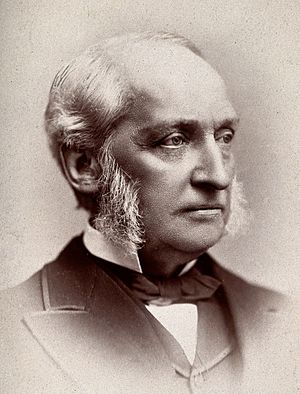George Johnson (physician) facts for kids
Quick facts for kids
Sir George Johnson
|
|
|---|---|
 |
|
| Born | 29 November 1818 Goudhurst, Kent, England
|
| Died | 3 June 1896 (aged 77) London, England
|
| Nationality | British |
| Occupation | Physician |
| Known for | Treatment of cholera and kidney diseases |
Sir George Johnson (29 November 1818 – 3 June 1896) was an important English doctor. He was known for his work on cholera and kidney diseases. Some of his ideas are not used by doctors today.
Contents
Early Life and Education
George Johnson was born on 29 November 1818. His hometown was Goudhurst, Kent, England. His father was a farmer. His mother's father sold timber. George went to the local grammar school.
In 1837, he started learning from his uncle. His uncle was a doctor in Cranbrook, Kent. In October 1839, George joined the medical school at King's College London. He was a very good student. He won many awards and a special scholarship for medicine. He won a Warneford prize in 1842. He finished his studies and became a doctor in 1843.
Medical Career
After finishing college, Johnson worked at King's College Hospital. He first worked as a house physician. Then he became a house surgeon. In 1850, he was made an honorary fellow of King's College. This was a special honor.
He became an assistant doctor at the hospital in 1847. By 1856, he was a full physician. From 1857 to 1863, he taught about medicines (pharmacology). From 1863 to 1876, he was a Professor of Medicine.
In 1862, Johnson was chosen to be a member of the senate. This was at the University of London. In 1865, he became a consulting doctor. This was for the British Home and Hospital for Incurables. In 1872, he became a fellow of the Royal Society. This is a very respected group for scientists.
From 1876 to 1886, Johnson taught Clinical Medicine at Kings. In 1883, he became a consulting doctor for the Royal College of Music. He was also a Censor at the Royal College of Physicians. In 1887, he became the Vice President of this important medical group.
In 1889, Queen Victoria made him a Physician-Extraordinary. This meant he was a special doctor to the Queen. He was made a knight in 1892. This is why he is called "Sir" George Johnson.
Personal Life and Death
In 1850, Johnson married Charlotte Elizabeth. She was the daughter of Lieutenant William White. They lived in Addington, Surrey. George and Charlotte had five children together.
A painter named Frank Holl painted his picture in 1888. This painting is now kept by the Royal College of Physicians of London.
Sir George Johnson died on 3 June 1896. He passed away at his home in Savile Row, London. He died from a brain bleed. There is a special memorial for him. It is in St James's Church, Piccadilly.
Medical Discoveries and Theories
Sir George Johnson was known for his knowledge of cholera. He also studied kidney diseases. He wrote several books about these health problems.
He was one of the first doctors to use new tools. These included the laryngoscope and the ophthalmoscope. The laryngoscope helps doctors look at the voice box. The ophthalmoscope helps them look at the eye.
He also brought back some important medical tests. One was the picric acid test for albumen. Another was the picric acid and potash test for sugar. These tests helped doctors check for certain substances in urine.
Johnson strongly supported the ideas of Richard Bright. Bright was another doctor who studied kidney disease. Johnson found that small arteries can get larger. This happens in a kidney condition called Bright's disease. He had a theory called the "stop-cock" theory. This theory tried to explain why these arteries got larger. It led to some disagreements with another doctor, Sir William Gull.
Cholera Treatment Ideas
Johnson did not agree with a common cholera treatment. This was called the "astringent treatment." Instead, he believed in the "evacuation treatment." He thought that getting rid of cholera bacteria was important. He believed this could be done by making the bowels empty.
In 1832, a doctor named William Brooke O'Shaughnessy suggested saline injections. These injections would put salts back into the body. People with cholera lose a lot of salts. Today, doctors know this is a good way to treat cholera. However, when Johnson looked at results from 1832, he saw that few patients got better. By 1848, saline injections were not used much.
Johnson thought that cholera was caused by a poison in the blood. He believed this poison made the right side of the heart get blocked. He saw vomiting and diarrhea as the body trying to get rid of this poison. He noticed that the blood of cholera patients looked different. But he did not think this was because of dehydration. He believed that people died because the poison stopped blood flow to the lungs. He even thought that bleeding a patient could help them get better. These ideas about cholera are not accepted by doctors today.
Images for kids


